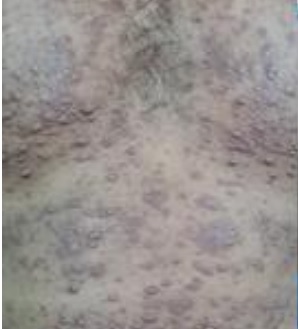Epidemiology and clinical features of patients with leprosy in a reference center in Paraguay
Main Article Content
Abstract
Introduction: leprosy (Hansen's disease) is a neglected infectious disease that affects skin and peripheral nerves, triggering neuropathies and complications such as deformities and disabilities.
Objective: determine epidemiological and clinical characteristics of patients with Leprosy in the Centro de Especialidades Dermatológicas of the Ministerio de Salud Pública y Bienestar Social of Paraguay, from January 2021 to December 2022.
Methodology: descriptive, observational, retrospective, cross-sectional study. Data management and analysis was carried out in an electronic spreadsheet (Excel from Microsoft Office 365 version 2405), then descriptive statistics were performed.
Results: 123 cases of leprosy were diagnosed, 45 (36.58 %) were women and 78 (63.42 %) were men; the ages were between 17 and 86 years, the most affected range was 41 to 50 years. 112 cases (91.06 %) were multibacillary leprosy. The most frequent sign was infiltrated plaque, present in 88 cases (71.54 %). 58 patients (47.15 %) presented lepromatous reactions, 31 cases of type 1
(53.45 %). 34 cases (27.64 %) presented grade 1 disability and 10 cases (8.13 %) grade 2 disability.
Conclusion: The profile of the patient with leprosy was male between 41 and 50 years, the majority being multibacillary cases. Early diagnosis and adequate treatment are essential to reduce the burden of the disease and disabilities.
Article Details

This work is licensed under a Creative Commons Attribution 4.0 International License.
References
Organización Mundial de la Salud. Hacia cero lepra: estrategia mundial contra la lepra (enfermedad de Hansen) 2021–2030. OMS: Oficina Regional para el Sudeste Asiático; 2020.. Disponible en: https://www.who.int/es/publications/i/item/9789290228509
Paraguay. Ministerio de Salud Pública y Bienestar Social. Programa Nacional de Control de Lepra. 2022. Disponible en: https://dgvs.mspbs.gov.py/programa-nacional-de-control-de-la-lepra/
World Health Organization. Global leprosy (Hansen disease) update, 2021: moving towards interruption of transmission. 2022. Disponible en: https://www.who.int/publications/i/item/whower9736-429-450
Moraes P, Eidt L, Koehlel A, Ransan L, Scrofeneker M. Epidemiological characteristics of leprosy from 2000 to 2019 in a state with low endemicity in southern Brazil. An Bras Dermatol. 2023;98(5):602-610. doi: 10.1016/j.abd.2022.08.009.
Alrehaili J. Leprosy classification, clinical features, epidemiology, and host immunological responses: failure of eradication in 2023. Cureus 2023;15(9): e44767. doi 10.7759/cureus.44767
Barba J. Lepra: enfermedad milenaria aún vigente. Rev Mex Patol Clin Med Lab. 2021; 68 (1): 18- 33. doi: 10.35366/101567.
Tavares A. Epidemiological profile of leprosy in the state of Mato Grosso: descriptive study. Einstein (São Paulo). 2021;19:eAO5622. doi: 10.31744/einstein_journal/2021AO5622
Chen K, Lin C, Su S, Chen K. Leprosy: a review of epidemiology, clinical diagnosis, and management. J. Trop. Med. 2022;2022:8652062. doi: 10.1155/2022/8652062.
Samudio G, Espínola R. Reacciones lepromatosas en pacientes adultos y pediátricos en un centro de referencia. Programa Nacional de Lepra, Paraguay. Rev. Nac. (Itauguá) [Internet]. 2016;8(2):4-18. doi: 10.18004/rdn2016.0008.02.004-018.
Coroliano C, Ataalpa W, Oliveira G, Niskier M. Factors associated with timing of lepra reactions in a cohort from 2008 to 2016 in Rondônia, Amazon Region, Brazil. Cad. Saúde Pública. 2021;37(12):e00045321. doi: 10.1590/0102-311X00045321

